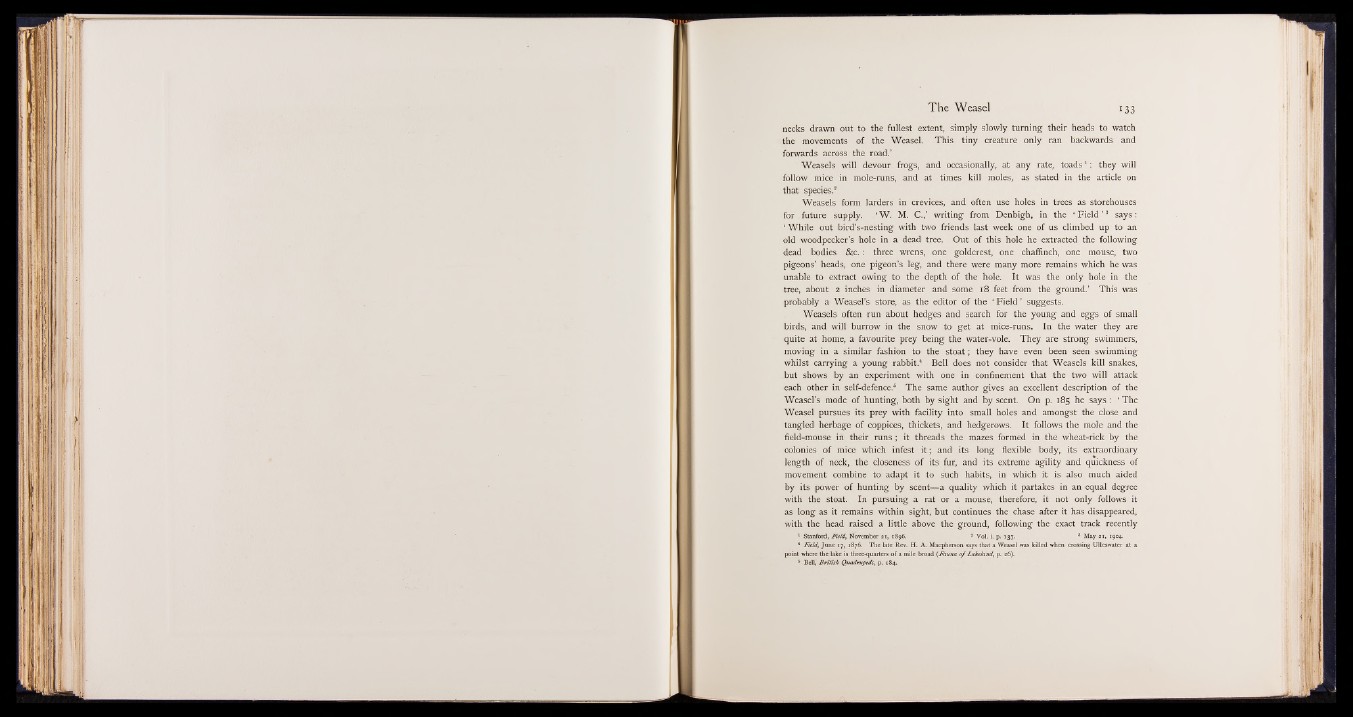
necks drawn out to the fullest extent, simply slowly turning their heads to watch
the movements of the Weasel. This tiny creature only ran backwards and
forwards across the road.’
Weasels will devour frogs, and occasionally, at any rate, toads1 : they will
follow mice in mole-runs, and at times kill moles, as stated in the article on
that species.2
Weasels form larders in crevices, and often use holes in trees as storehouses
for future supply. ‘ W. M. C.,’ writing from Denbigh, in the ‘ Field ’ 8 sa y s :
‘ While out bird’s-nesting with two friends last week one of us climbed up to an
old woodpecker’s hole in a dead tree. Out of this hole he extracted the following
dead bodies &c. : three wrens, one goldcrest, one chaffinch, one mouse, two
pigeons’ heads, one pigeon’s leg, and there were many more remains which he was
unable to extract owing to the depth of the hole. It was the only hole in the
tree, about 2 inches in diameter and some 18 feet from the ground.’ This was
probably a Weasel’s store, as the editor of the ‘ Field ’ suggests.
Weasels often run about hedges and search for the young and eggs of small
birds, and will burrow in the snow to get at mice-runs. In the water they are
quite at home, a favourite prey being the water-vole. They are strong swimmers,
moving in a similar fashion to the stoat; they have even been seen swimming
whilst carrying a young rabbit.4 Bell does not consider that Weasels kill snakes,
but shows by an experiment with one in confinement that the two will attack
each other in self-defence.6 The same author gives an excellent description of the
Weasel’s mode of hunting, both by sight and by scent. On p. 185 he says : ‘ The
Weasel pursues its prey with facility into small holes and amongst the close and
tangled herbage of coppices, thickets, and hedgerows. It follows the mole and the
field-mouse in their runs; it threads the mazes formed in the wheat-rick by the
colonies of mice which infest i t ; and its long flexible body, its extraordinary
length of neck, the closeness of its fur, and its extreme agility and quickness of
movement combine to adapt it to such habits, in which it is also much aided
by its power of hunting by scent—a quality which it partakes in an equal degree
with the stoat. In pursuing a rat or a mouse, therefore, it not only follows it
as long as it remains within sight, but continues the chase after it has disappeared,
with the head raised a little above the ground, following the exact track recently
1 Stanford, Field, November 2r, 1896. a Vol. i. p. 137. 3 May 21, 1904.
4 Field, June 17, 1876. The late Rev. H. A. Macpherson says that a Weasel was killed when crossing Ulleswater at a
point where the lake is three-quarters of a mile broad (Fauna o f Lakeland, p. 26).
3 Bell, British Quadrupeds, p. 184.